Denis Dwyer
Paddler
Pyramid Style Tents
I have received numerous requests for information from WCP forum readers on the pyramid style tent that I use on my kayaking trips. In an effort to answer some of these questions I submit this post.
The tent that I use was made by Dana Designs and is no longer available. I list several sources of pyramid style tents on the “links” page of my web site. A link to my site is provided at the end of this post.
Positive points:
It is quick and easy to set up and take down. After securing the four corners with stakes or rocks the center pole can be put in position. Four more stake-out points finish the set-up.
The kayak provides 4 of the 9 stake-out points. It is super easy to connect the front two corners to the bow and stern handles of the kayak. The two guy lines for the door connect to eyelets near the cockpit.
It provides the ability to see what is going on outside of the tent in every direction. I find this to be a big advantage when camping in bear country. If I hear a noise outside, it is easy to have a look in any direction.
It is compact and lightweight. The whole tent with guy lines attached gets stuffed into a small nylon bag about the size of a football.
It does not require a completely flat area for set-up. Many times I set the tent up on sloping gravel and just level a small spot to sleep on.
Cooking can be done inside the tent. Since there is no floor and lots of ventilation, cooking on rainy days is not a problem.
Entry and exit can be accomplished without opening the door. I often enter and exit the tent by just slipping under any point that is convenient.
The single center pole is nearly unbreakable. The four piece pole all fits into the largest section.
The design provides good rain and wind resistance. It is naturally stable and sheds wind and rain easily.
Rocks can be used instead of tent stakes. I use 12 foot (3.66 meter) long pieces of parachute cord tied into loops for guy lines. These make attaching to rocks with a girth hitch easy.
Pyramid tents work much better than tarps in almost every situation. Tarps are harder to set up and do little to shelter you from wind - blown rain.
Negative points:
There is no floor or mosquito netting. It is necessary to use a ground cloth to keep your gear off of the bare ground. You will need to use a mosquito head net at some locations.
Since there is no mosquito netting, it is necessary to use a bivy-sack to keep bugs from biting you while sleeping.
Here are some photos of my tent in use.
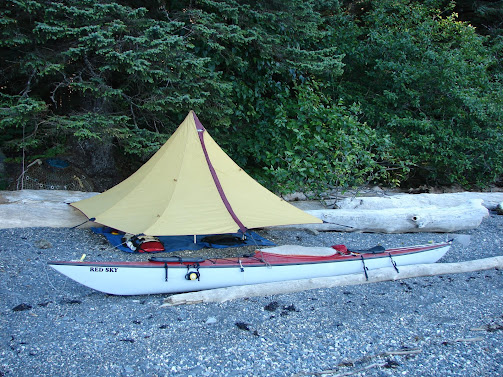
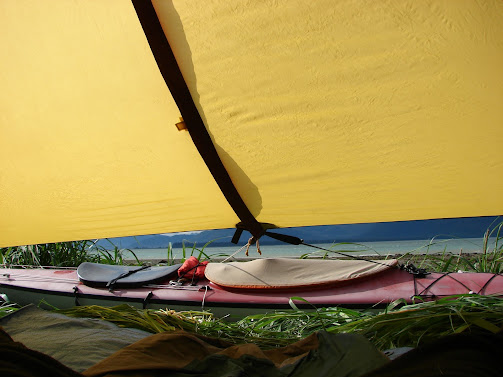
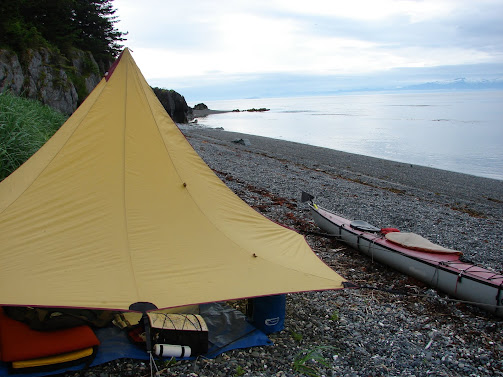
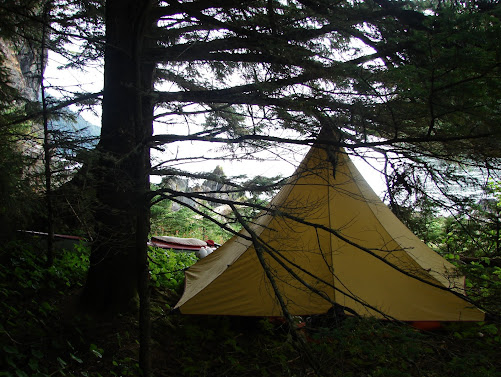
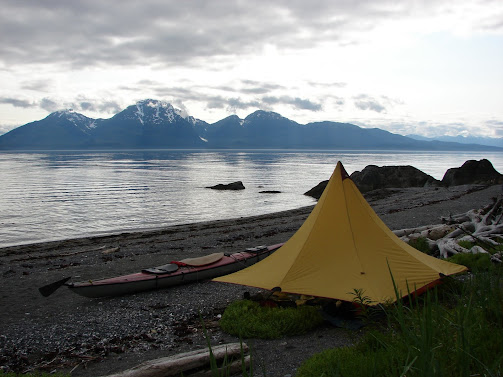
I have received numerous requests for information from WCP forum readers on the pyramid style tent that I use on my kayaking trips. In an effort to answer some of these questions I submit this post.
The tent that I use was made by Dana Designs and is no longer available. I list several sources of pyramid style tents on the “links” page of my web site. A link to my site is provided at the end of this post.
Positive points:
It is quick and easy to set up and take down. After securing the four corners with stakes or rocks the center pole can be put in position. Four more stake-out points finish the set-up.
The kayak provides 4 of the 9 stake-out points. It is super easy to connect the front two corners to the bow and stern handles of the kayak. The two guy lines for the door connect to eyelets near the cockpit.
It provides the ability to see what is going on outside of the tent in every direction. I find this to be a big advantage when camping in bear country. If I hear a noise outside, it is easy to have a look in any direction.
It is compact and lightweight. The whole tent with guy lines attached gets stuffed into a small nylon bag about the size of a football.
It does not require a completely flat area for set-up. Many times I set the tent up on sloping gravel and just level a small spot to sleep on.
Cooking can be done inside the tent. Since there is no floor and lots of ventilation, cooking on rainy days is not a problem.
Entry and exit can be accomplished without opening the door. I often enter and exit the tent by just slipping under any point that is convenient.
The single center pole is nearly unbreakable. The four piece pole all fits into the largest section.
The design provides good rain and wind resistance. It is naturally stable and sheds wind and rain easily.
Rocks can be used instead of tent stakes. I use 12 foot (3.66 meter) long pieces of parachute cord tied into loops for guy lines. These make attaching to rocks with a girth hitch easy.
Pyramid tents work much better than tarps in almost every situation. Tarps are harder to set up and do little to shelter you from wind - blown rain.
Negative points:
There is no floor or mosquito netting. It is necessary to use a ground cloth to keep your gear off of the bare ground. You will need to use a mosquito head net at some locations.
Since there is no mosquito netting, it is necessary to use a bivy-sack to keep bugs from biting you while sleeping.
Here are some photos of my tent in use.

